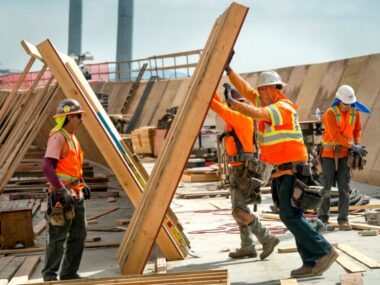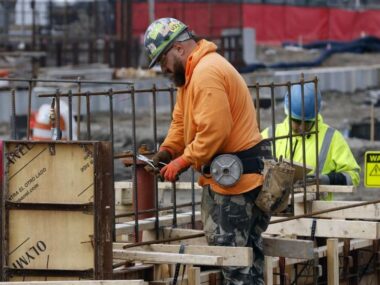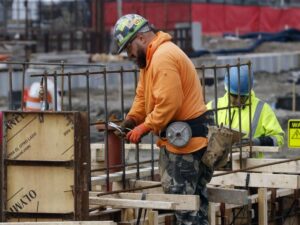The United States, a nation synonymous with innovation and architectural marvels, has long captivated architects worldwide. From the iconic skyscrapers of New York to the modernist marvels of California, American cities offer a dynamic and inspiring backdrop for ambitious professionals. However, for international architects, navigating the complexities of the US job market and securing a coveted position can seem like an insurmountable challenge.
This guide serves as your compass, illuminating the path towards achieving your American dream. We will delve into the intricacies of finding architect jobs in the USA with visa sponsorship, exploring the available visa options, providing actionable job search strategies, and offering essential tips for a successful visa application.
Whether you’re a recent graduate eager to gain international experience or an established professional, seeking new horizons, this guide will equip you with the knowledge and resources necessary to embark on this exciting journey.
We understand that pursuing a career in the US involves navigating unfamiliar territory. Therefore, we will address common concerns, such as cultural differences, building codes, and professional licensing requirements. Our aim is to empower you with the confidence and clarity needed to make informed decisions and confidently pursue your architectural aspirations in the United States.
Why Choose the USA for Architect Jobs?
The United States stands as a global beacon for architectural innovation, offering a unique blend of opportunities and challenges that can significantly advance an architect’s career. Here’s a deeper dive into why the USA should be on your radar:
-
A Hub of Architectural Excellence:
The US boasts an incredibly diverse architectural landscape, a testament to its rich history and cultural tapestry. From the soaring skyscrapers of New York City to the iconic mid-century modern architecture of California, the country offers a unique opportunity to engage with a wide range of architectural styles and design philosophies. This exposure can broaden your horizons, inspire creativity, and enhance your design repertoire.
-
Cutting-Edge Technology and Innovation:
The United States is at the forefront of architectural technology and innovation. Leading-edge Building Information Modeling (BIM) software, advanced construction techniques, and sustainable design practices are widely adopted across the industry. By working in the US, you’ll gain access to cutting-edge tools and technologies, allowing you to stay ahead of the curve and enhance your professional development.
-
A Dynamic and Competitive Market:
The US architecture market is highly competitive, demanding excellence and pushing architects to constantly strive for innovation. This competitive environment can be incredibly stimulating, encouraging you to refine your skills, expand your knowledge, and push the boundaries of your creativity.
-
Opportunities for Professional Growth:
The US offers numerous opportunities for professional growth and advancement. Continuing education programs, professional organizations, and networking events abound, providing ample opportunities for architects to enhance their skills, expand their knowledge, and build valuable professional connections.
-
A Global Hub for Architectural Influence:
The United States has a profound influence on the global architectural landscape. Many renowned architectural firms and thought leaders are based in the US, making it an ideal location to gain exposure to international trends and collaborate with leading professionals in the field.
-
A Land of Opportunities:
The US offers a dynamic and entrepreneurial environment that encourages innovation and risk-taking. Whether you aspire to start your own firm, specialize in a niche area of architecture, or contribute to groundbreaking research and development, the US provides the platform and resources to turn your ambitions into reality.
-
A High Standard of Living:
The US offers a high standard of living, with access to excellent healthcare, education, and cultural amenities. This can significantly enhance your quality of life and provide a fulfilling experience both personally and professionally.
While the US job market presents its own set of challenges, the rewards for ambitious and talented architects can be substantial. By embracing the competitive environment, leveraging the available resources, and continuously striving for excellence, you can build a successful and rewarding career in the United States.
Visa Options for Foreign Architects in USA
The US architectural scene beckons talented architects from around the world. But bridging the gap between your skills and an American firm can be tricky. Fear not, this guide dives deep into the visa options available for foreign architects seeking to work in the USA.
Popular Choices:
- H-1B Visa: This is the most common option for foreign professionals with a bachelor’s degree (or equivalent) in their field. It’s ideal for architects as the role typically requires such a qualification. However, H-1B visas have a quota system and can be competitive. Employers must also demonstrate that the position couldn’t be filled by a qualified US citizen and that your salary meets prevailing wages.
- TN Visa: This visa caters to citizens of Canada and Mexico under the North American Free Trade Agreement (NAFTA). It allows them to work in specific professions, including architecture, for an initial period of three years with the possibility of extension.
- E-2 Treaty Investor Visa: This visa is for individuals from countries with a treaty of commerce and navigation with the US. It allows them to run and develop a business in which they have invested a substantial amount of capital. This could be an option for architects who want to establish their own architectural firm in the USA.
- J-1 Visa: This visa is for cultural exchange programs. It can be an option for architects participating in internship or trainee programs with US architecture firms. Architect-US is an example of a company that facilitates J-1 visa sponsorship for such programs.
Beyond the Common:
- O-1 Visa: This visa is for individuals of extraordinary ability in their field. While not as common for architects, it could be an option for highly acclaimed and award-winning architects with a proven track record of exceptional achievement.
- EB-5 Visa: This visa is for immigrant investors who create jobs in the USA by investing a significant amount of capital in a US-based business. While not directly related to employment, it can ultimately lead to permanent residency and the freedom to work as an architect without visa restrictions.
Choosing the Right Visa
The best visa option for you will depend on your individual circumstances, education, experience, and career goals. Consulting with an immigration attorney specializing in employment visas is highly recommended. They can guide you through the complexities of each visa type, assess your eligibility, and ensure a smooth application process.
Remember, securing a visa can be a time-consuming and complex process. Starting early, gathering the necessary documentation, and having a clear understanding of the specific requirements for each visa option will increase your chances of success.
Architect Jobs in the USA with Visa Sponsorship for Foreign Workers
The United States offers a diverse range of architectural opportunities for foreign workers, each with unique challenges and rewards. Here’s a closer look at some of the most common categories:
-
Project Architect
Average Salary: $75,000 – $120,000 per year
Job Description: Project Architects are the backbone of any architectural firm. They oversee all phases of a building project, from initial concept and design to construction and completion. This involves managing budgets, schedules, and teams, ensuring the project meets client needs and adheres to building codes and regulations.
Key Responsibilities:
- Developing design concepts and preparing construction documents.
- Coordinating with engineers, contractors, and other consultants.
- Conducting site visits and resolving construction issues.
- Preparing presentations and communicating project progress to clients.
Skills Required: Strong leadership, communication, and problem-solving skills; excellent design and technical skills; proficiency in CAD software and building codes.
-
Architectural Designer
Average Salary: $50,000 – $80,000 per year
Job Description: Architectural Designers focus on the creative aspects of building design, developing initial concepts, sketches, and 3D models. They work closely with Project Architects to translate client visions into functional and aesthetically pleasing designs.
Key Responsibilities:
- Creating design concepts and developing presentation materials.
- Conducting research and analyzing design options.
- Preparing sketches, drawings, and 3D models.
- Assisting with the development of construction documents.
Skills Required: Strong design and visualization skills; proficiency in CAD software and 3D modeling tools; creativity and imagination.
-
Urban Planner
Average Salary: $65,000 – $100,000 per year
Job Description: Urban Planners focus on the development and design of cities and communities. They analyze land use patterns, transportation systems, and social and economic factors to create sustainable and livable urban environments.
Key Responsibilities:
- Developing and implementing urban plans and policies.
- Conducting research and analyzing data related to urban development.
- Preparing reports and presentations to communicate planning proposals.
- Working with community stakeholders to gather input and address concerns.
Skills Required: Strong analytical and problem-solving skills; knowledge of urban planning principles and theories; excellent communication and presentation skills.
-
Landscape Architect
Average Salary: $60,000 – $95,000 per year
Job Description: Landscape Architects design outdoor spaces, such as parks, gardens, and green roofs. They consider environmental factors, such as soil, water, and vegetation, to create functional and aesthetically pleasing outdoor environments.
Key Responsibilities:
- Developing site plans and planting plans.
- Selecting and specifying plant materials.
- Designing drainage and irrigation systems.
- Conducting site analysis and environmental impact assessments.
Skills Required: Strong design and visualization skills; knowledge of horticulture and environmental science; proficiency in landscape design software.
-
Interior Designer
Average Salary: $55,000 – $90,000 per year
Job Description: Interior Designers focus on the design of interior spaces, such as residential and commercial buildings. They select finishes, furniture, and lighting to create functional and aesthetically pleasing environments.
Key Responsibilities:
- Developing interior design concepts and preparing presentations.
- Selecting furniture, fabrics, and finishes.
- Creating floor plans and elevations.
- Coordinating with contractors and suppliers.
Skills Required: Strong design and aesthetic sense; knowledge of interior design principles and trends; excellent communication and presentation skills.
-
Architectural Historian
Average Salary: $50,000 – $80,000 per year
Job Description: Architectural Historians research and document the history of buildings and architectural styles. They may work as researchers, educators, or consultants, providing valuable insights into the evolution of built environments.
Key Responsibilities:
- Conducting research and writing about the history of architecture.
- Surveying and documenting historic buildings.
- Preparing reports and presentations on architectural history.
- Teaching courses on architectural history at universities or colleges.
Skills Required: Strong research and writing skills; knowledge of architectural history and theory; excellent communication and presentation skills.
-
BIM (Building Information Modeling) Technician
Average Salary: $55,000 – $85,000 per year
Job Description: BIM Technicians use specialized software to create 3D models of buildings and other structures. These models provide detailed information about the building’s design, construction, and operation.
Key Responsibilities:
- Creating and maintaining 3D models of buildings.
- Extracting data from BIM models for analysis and construction purposes.
- Coordinating with architects, engineers, and contractors.
- Staying up-to-date on the latest BIM software and technologies.
Skills Required: Proficiency in BIM software such as Revit, AutoCAD, and Navisworks; strong technical skills and attention to detail; excellent problem-solving skills.
-
Sustainability Consultant
Average Salary: $60,000 – $100,000 per year
Job Description: Sustainability Consultants work with architects and developers to design and build environmentally friendly buildings. They assess the environmental impact of building projects and recommend strategies for reducing energy consumption, water usage, and carbon emissions.
Key Responsibilities:
- Conducting environmental assessments and life-cycle analyses.
- Developing sustainability strategies and implementing green building practices.
- Recommending energy-efficient building materials and systems.
- Preparing sustainability reports and presentations.
Skills Required: Knowledge of sustainable building principles and green building standards; understanding of environmental science and engineering principles; strong analytical and problem-solving skills.
This list provides a brief overview of some of the most common and in-demand architecture jobs in the USA. The specific duties and responsibilities of each role may vary depending on the size and type of firm, as well as the specific project requirements.
Qualities and Requirements for Architect Jobs with Visa Sponsorship in the USA
Securing an architect job with visa sponsorship requires possessing not only exceptional skills but also meeting specific requirements. This guide unpacks the key qualities and qualifications employers seek in foreign architects, along with the essential steps to navigate the visa sponsorship process.
Essential Qualities for Success:
Foreign architects seeking visa sponsorship must demonstrate a strong foundation in several key areas:
- Educational Background: A bachelor’s degree in architecture from an accredited institution is a fundamental requirement.
- Proven Experience: A solid track record with a portfolio showcasing your design skills and experience working on projects relevant to the firm’s focus is crucial.
- Software Proficiency: Mastery of industry-standard design software like AutoCAD, Revit, and SketchUp is essential for effective project execution.
- Communication Skills: The ability to communicate clearly and concisely, both verbally and in writing, is vital for collaboration with clients, colleagues, and engineers from diverse backgrounds.
- Cultural Adaptability: A willingness to embrace new working styles, regulations, and cultural nuances within the US architectural landscape is essential.
Additional Desirable Qualities:
While not always mandatory, possessing these qualities can significantly enhance your candidacy:
- Professional Licensure: While not always required initially, pursuing licensure in the state where you plan to work demonstrates commitment and opens doors to a wider range of opportunities.
- Advanced Degrees: A Master’s degree in architecture or a related field can give you a competitive edge, especially for specialized positions.
- Leadership Skills: For senior-level positions, demonstrating leadership experience in managing projects and teams can be highly sought-after.
Understanding Visa Requirements:
The specific visa requirements will depend on your individual circumstances. Here’s an overview of the most common options:
- H-1B Visa: This is the most common option for foreign professionals with a bachelor’s degree in their field. However, it’s subject to quotas and requires the employer to demonstrate the position couldn’t be filled by a US citizen.
- EB-5 Visa: This visa is for immigrant investors who create jobs in the USA. While not directly related to employment, it can ultimately lead to permanent residency.
- J-1 Visa: This visa is for cultural exchange programs and can be an option for architects participating in internship or trainee programs with US firms.
Partnering for Success:
- Immigration Attorney: Consult with an immigration attorney specializing in employment visas to navigate the legal complexities and ensure a smooth application process.
- Recruitment Agencies: Partnering with agencies specializing in placing foreign architects in the USA can connect you with relevant job openings and guide you through the visa sponsorship process.
By honing your skills, acquiring the necessary qualifications, and navigating the visa sponsorship process strategically, you can unlock the door to a fulfilling career as an architect in the USA. With your unique perspective and talent enriching the American architectural landscape, your dream of working on groundbreaking projects can become a reality.
Key Considerations Before Applying for Architect Jobs in the USA
Before embarking on your journey to secure an architect job in the USA, it’s crucial to carefully consider the following factors:
-
Visa Requirements and Eligibility:
- Thoroughly research visa options: Understand the specific requirements for each visa category (H-1B, O-1, etc.) and determine which one best suit your qualifications and career goals.
- Assess your eligibility: Ensure you meet the eligibility criteria for your chosen visa category, including education, experience, and language proficiency.
- Consult with an immigration attorney: Seek professional guidance to navigate the complex visa application process and ensure your application is complete and accurate.
-
Licensing and Certification:
- Research state licensing requirements: Familiarize yourself with the specific licensing requirements of the state(s) where you intend to work. This typically includes passing the Architect Registration Examination (ARE) and completing an Architectural Experience Program (AXP).
- Evaluate your foreign credentials: Determine if your foreign education and experience meet the requirements for licensure in the USA. You may need to have your credentials evaluated by a recognized agency.
- Explore licensure reciprocity options: If you are already licensed in another country, investigate potential reciprocity agreements that may streamline the licensure process in the USA.
-
Financial Considerations:
- Estimate living expenses: Research the cost of living in the desired location, including rent, transportation, food, and healthcare.
- Factor in visa and licensing fees: Consider the costs associated with visa applications, legal fees, and licensure exams.
- Plan your budget: Create a realistic budget to ensure you can comfortably afford the expenses associated with living and working in the USA.
-
Cultural and Professional Considerations:
- Research cultural differences: Understand the cultural nuances of working in the USA, including communication styles, workplace etiquette, and professional norms.
- Familiarize yourself with building codes and standards: Research and understand the building codes and standards that are specific to the USA.
- Network with professionals: Connect with other architects who have successfully transitioned to the USA to gain insights and advice.
-
Personal and Professional Goals:
- Define your career goals: Clearly define your short-term and long-term career goals and how working in the USA will help you achieve them.
- Assess your personal preferences: Consider your personal preferences for lifestyle, location, and work environment when choosing a location and employer.
- Prepare for the challenges: Be prepared for the challenges associated with relocating to a new country, including cultural adjustment, language barriers, and the competitive job market.
By carefully considering these factors and conducting thorough research, you can increase your chances of successfully navigating the challenges of finding and securing an architect job in the USA.
See More Architect Jobs for Application
Conclusion
Securing any of the available architect jobs in the USA with visa sponsorship requires careful planning, thorough research, and a proactive approach. By understanding visa requirements, identifying suitable job opportunities, and building a strong professional network, international architects can increase their chances of success. Remember to prioritize your professional development, adapt to the American workplace culture, and embrace the challenges and opportunities that await you in this dynamic and rewarding field.








